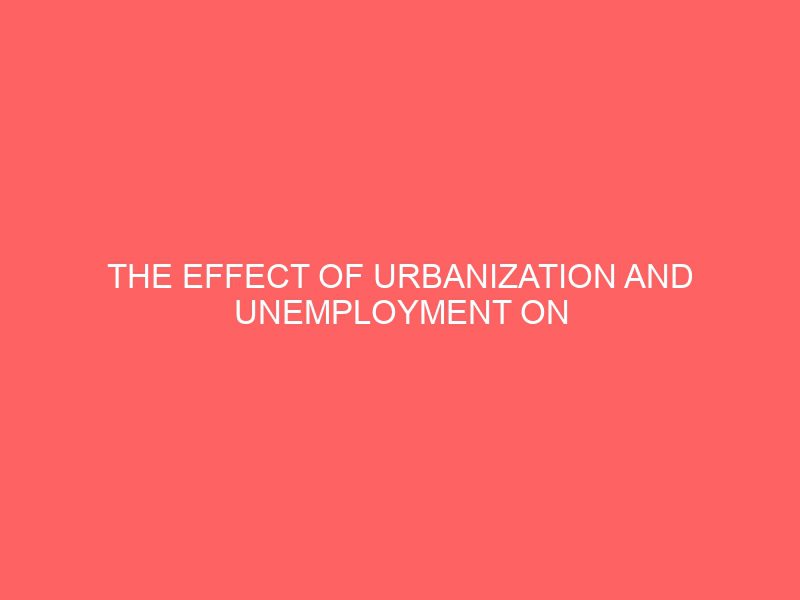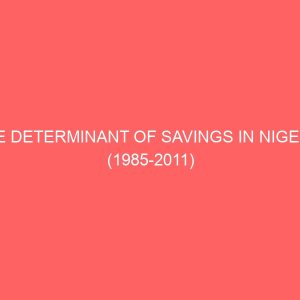Description
CHAPTER ONE
INTRODUCTION
1.1 BACKGROUND OF THE STUDY
The rate of urbanization is increasing in both the developed and developing countries. However, rapid urbanization, particularly the growth of large. Cities and the associated problems of unemployment, poverty, inadequate health care, poor sanitation, urban slums and environmental degradation pose a formidable challenge in developing countries. Available statistics shows that more than half of the world lives in urban areas at the end of 2010 from 49% (3.2billion) in 2008. the same report projected that figure is likely to rise to 60% (4.9billion) by 2030. according to the UN state of the world population 2007 report, the majority of people worldwide will be living in towns or cities, for the first time in history, this is referred to as the arrival of the “urban millennium” or the ‘tipping point’. In regard to future trends, it is estimated 93% of urban growth will occur in developing nations, with 80% of urban growth occurring in Asia and Africa
Urbanization simply defined, is the shift from a rural to an urban society and involves an increase in the number of people in urban areas during a particular year. Urbanization is the outcome of social, economic and political development that lead to urban concentration and growth of large cities changes in the land use and transformation from rural to metropolitan pattern of organization and governance.
Although Urbanization is the driving force for modernization, economic growth and development, there is increasing concern about the effect of expanding cities, particularly on human health, livelihood and environment. The implication of rapid urbanization and demographic trends for employment, food, security, water supply, shelter and sanitation, especially the disposal of waste (solid and liquid) that the cities produce are staggering (UNCED, 1992). The question that arises is whether the current trend in urban growth is sustainable considering the accompanying urban challenge such as unemployment, poverty and environmental degradation especially in the developing countries.
Thus, of significant attention to us is the problem of unemployment as a result of urbanization in the Nigerian urban areas. Urban unemployment or unemployment in the urban Nigeria stands for the conglomeration of people with diversity background, willing and able to work in the urban areas resulting in pressure of supply of labour over the demand for labour. Thus causing
joblessness. Implicit in this definition are the following for excessive manpower supply of labour over manpower demand for labour, there may have a risen a situation whereby job seekers irrelevant or not needed education qualification, both the public and private sector may not have involved a calculated policy to afford them the opportunity for self employment through planned programs. In
Nigeria it is estimated that in 1900 about 95% of Africa’s inhabitants South of Sahara lived from the Primary occupations of farming, hunting & gathering, cattle anomalism, and fishing (Aase, 2003:1) meaning that less than 5% were urban. In 1950 (the start of the independence period) 14.7% of Africa’s inhabitants were urban in 2000 had it risen to 37.2% and it is expect 3.76%, 3.35% per year (UN, 2002) the Nigerian city of Lagos in 1963 had 665000 inhabitants (Rakodi, 1991) and 8.7miliion in 2000 is expected to become the worlds 11th biggest city by 2015 with 16million inhabitants (UN, 2002).
Therefore, a survey by the UN International labour organization (ILO) indicated that as many as 3 million Nigerians fall within the working age out of this, 90 percent or about 3 million are unemployed. A further study on the geographical distribution of those unemployed shows that as many as 2.7million out of the 3 million live in urban area (ILO survey report African concord 1996).
Surely, it is very difficult to ascertain the current rate of unemployment in Nigeria but evidence and indication of urban unemployment overwhelming. There is no gainsaying that there are significant correlation between urbanization and unemployment in Nigeria though Urbanization is also a consequence of industrialization or economic specialization. It connotes the movement of people principally from agricultural productivity. The process involves changing relationship and interaction.
Conclusively, there exists convincing evidence that the bulk of urban unemployment in the country is among able bodied youths. Data shows that in 2009 at the recent Nigerian economic summit, group (NESG) policy dialogue on the Nigeria economy, Nigeria’s minister of finance quoted data from the National Bureau of statistics (NBS) saying that “unemployment in Nigeria is running at around 19.7 percent on average and almost half of 15-24 year olds living in urban areas are jobless” the theme of the policy dialogue growth through public private partnership.
1.2 STATEMENT OF PROBLEM
The Nigeria population of about 150 million with a growth rate of 3.2%, more youths are getting into the educational system, more .youths are also graduating, more are getting into the urban labour market while more are also becoming unemployed. Some of the manifestation of the failing of both the educational system and the economy are unemployment and underemployment. Urban unemployment is growing progressively worse due to rural to urban migration. This migration is as a result of high concentration of Infrastructure and amenities in the urban areas, coupled with favorable living conditions and standard of living.
Some adolescents do not think about any job at all until they are faced with the issue of locating one in the urban center. The contributing fact to this is that career guidance is minimally emphasized in our school curriculum. When the youths are not formally provided with occupational information which forms the basis for realistic occupational choice, some often accept any job for which they are not well prepared for these result into inefficiency, low productivity, low or lack of job satisfaction and they all culminate into underdevelopment.
1.3 OBJECTIVES OF THE STUDY
The objectives of the study are:
- To examine the relationship between urbanization and unemployment in the development of Nigeria.
- To determine the implication of urbanization on the development of Nigeria GDP per say.
- To determine also the implication of unemployment of Nigeria. GDP per say.
- To proffer solution that will bring these problems to the barest minimum in Nigeria.
1.4 RESEARCH QUESTION
The research questions for this study are as follows:
- Does urbanization and unemployment have any relationship in development of Nigeria?
- Does urbanization contribute to the output of Nigeria?
- What are the implications of unemployment on the development of Nigeria?
- What are the possible solutions that will bring these problems to the barest minimum in Nigeria?
1.5 STATEMENT OF HYPOTHESIS
For the purpose of this study, the following hypothesis will be tested.
H0: Urbanization has no significant impact on economic growth.
H1: Urbanization has significant impact on economic growth.
H0: Unemployment has no significant impact on economic growth.
HI: Unemployment has significant impact on economic growth.
1.6 SIGNIFICANCE OF THE STUDY
The significance of this study are as follows:
The study would provide an econometric basis upon which to examine the effect of urbanization and unemployment on Nigeria’s economy which would be useful to Nigeria as a whole. ,
The study will add to intellectual value of Nigerians. The knowledge of the effect of urbanization and unemployment will be very useful as it will broaden individuals outlook, sharpen their intellect. and inculcate in them the habit of balanced thinking. The study will also .educate the government and youth who ignored agriculture in pursuit of white collar jobs in the office.
Finally, the study will serve as a reference material for further studies.
1.7 SCOPE OF THE STUDY
Though the issue of urbanization and unemployment moves in the same direction and this problem has eaten deep into the marrows of the society of Nigeria and our main focus is how to solve the problem of urbanization and unemployment in Nigeria.
1.8 DEFINITION OF TERMS
Unemployment: (According to Pigou,) the greatest exponent of the classical view, unemployment defined as a resulted from the rigidity in the wage structure and interference in the working of free market system in the form of trade union legislation, minimum wage legislation, etc..
Unemployment: {According to everyman’s Dictionary of Economics) defines unemployment as “involuntary idleness of a person willing to work at the prevailing rate of pay but unable to find it”.
“Economic Growth”: (Berger 1965) stated that Economic growth means more output and changes in the technical skills, knowledge productive education, health managerial capacity) arrangement by which it is produced and distributed. Growth may well not only involve more output derived from greater amounts of inputs but also greater, efficiency.
Economic Growth refers to the steady process by which the productive capacity of the economy is increased over time to bring about increases in the output of goods and services and rising levels of national income. This corroborates kindle Berger’s view of economic in (1965).
The economic growth of any country is measured by the rate of increase in its (GNP) or (GDP) or better still by the total output or by per capital output.
Gross Domestic Product (GDP): According to Okowa, W. J. (1995), defined gross domestic product as the money value of the total output of goods and services produced within the geographical confines (that is, inhabitants) of a country’s territory in a given year.
Economic Development: refers to as the problems of the economic development of underdeveloped countries. Though the study of economic development has attracted the attention of economists right from Adam Smith down to Marx and Keynes, yet they were mainly interested in the problems which essentially static in nature and largely related to a western European framework of social and cultural institutions.
Economic Development: (According to Schumpeter) defines development as a discontinuous and spontaneous changer in the stationary state which forever alters and displaces the equilibrium state previously existing. This view of Schumpeter has been widely accepted and elaborated by the majority of economists.
Economic Development: (According to kindle Berger,) Economic Development implies both more output and changes in the technical and institutional arrangement by which it is produced and distributed.
Development: goes beyond this to simply changes in the composition of output) and the allocation of inputs by the sectors. Recent statistics released by the National Bureau of Statistics (NBS) showed that about 10million Nigerians were unemployed in Nigeria at March, 2010. The NBS defines the unemployment rate as the percentage of Nigeria’s labor force that is qualified to work but did not work for atleast 39 hours in the week preceding the survey. The total labor force is made up of people aged between 15 to 64 years and excludes students, home keepers, retired persons, stay-at-home parents and persons unable to work or not interested in work.
1.9 ORGANIZATION OF THE STUDY
After the preliminary pages which consist of the cover, certification, dedication, acknowledgement, abstract and table of content pages. The study will be set under five chapters; they are the introductory aspect of the work which forms the chapter one, the review of related literature, in chapter two, the research methodology, in chapter three, the presentation I of Analysis an 3 interpretation of data in chapter four and summary, conclusion and recommendation which forms the aspect of chapter five. The work will be rounded up with references and Appendix.








Reviews
There are no reviews yet.